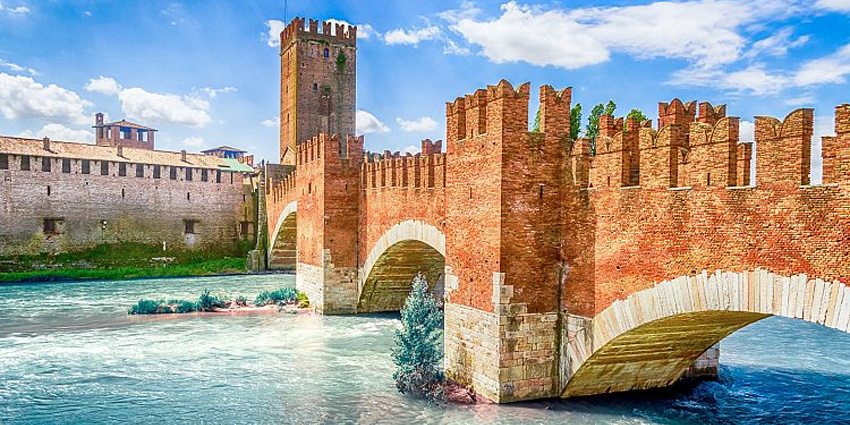
Castelvecchio in Verona: History, Art, and Medieval Charm in the Heart of Veneto
Among the many castles to visit in Veneto, Castelvecchio in Verona holds a place of exceptional importance.
Located in the heart of the city, along the banks of the Adige River, this imposing fortified complex is one of the most significant examples of medieval military architecture in northern Italy. It is a place that tells the story of centuries of history, battles, and transformations, offering visitors an authentic journey into Verona’s past.
The Origins: The Castle of San Martino in Aquaro
Castelvecchio was built in the mid-14th century, between 1354 and 1356, by order of Cangrande II della Scala, a member of the powerful Scaliger dynasty that ruled Verona during the late Middle Ages. The fortress was designed to meet precise strategic and defensive needs: Cangrande II, aware of the political and military tensions of the time, wanted to provide the city with an impregnable stronghold that could serve both as a military residence and a refuge in case of uprisings or external attacks.
Originally known as the Castle of San Martino in Aquaro, named after the parish on which it was built, the fortress was later renamed Castelvecchio (“Old Castle”) to distinguish it from a new castle erected by the Visconti family on the hill of San Pietro.
Architecture and Features of the Castle
Castelvecchio immediately impresses with its monumental size and the solidity of its structure. Built primarily of red brick, typical of Scaliger architecture, the complex has an asymmetrical layout adapted to the shape of the terrain and the proximity to the river.
The castle features crenellated towers, inner courtyards, walkways, and fortified bastions. One of its most spectacular elements is the fortified bridge of Castelvecchio, which connects the fortress to the opposite bank of the Adige. Designed with strategic purposes in mind, the bridge offered a quick escape route in case of siege while also providing an important control point over access to the city.
The bridge is especially stunning at sunset, when the sunlight reflects off the bricks and the waters of the river, creating a magical and evocative scene. The towers and battlements rise against the sky, forming one of Verona’s most iconic and romantic views.
Castelvecchio Today: A Museum and Cultural Treasure
Over the centuries, Castelvecchio underwent numerous transformations, particularly during the Venetian and Austrian rule, and later under the Kingdom of Italy. In the 20th century, a significant restoration was carried out by architect Carlo Scarpa, who helped convert the structure into a museum space.
Today, the castle houses the Castelvecchio Museum, one of Verona’s most important art collections. Visitors can admire a rich array of works, including paintings by Pisanello, Giovanni Bellini, Tintoretto, and Paolo Veronese, as well as medieval sculptures, ancient weapons, bronze artifacts, ceramics, and jewelry. The exhibition path is designed to integrate harmoniously with the castle’s architecture, allowing visitors to fully appreciate both the artworks and the historical setting in which they are displayed.
A Symbol of Verona
Castelvecchio is not only a historical monument but also a cultural and symbolic landmark for the city of Verona. Second only to the Arena in terms of recognition, it is one of the city’s most photographed and admired sites, and a must-visit for those exploring the rich historical landscape of Veneto.
Its central location makes it easily accessible from all parts of the old town. A walk along the Adige River leading to the castle is a pleasant experience in itself, offering picturesque views and quiet corners perfect for photography enthusiasts or anyone seeking a moment of peace in a historic setting.
Castelvecchio and the Urban Landscape
Beyond its historical and artistic significance, Castelvecchio plays a key role in shaping Verona’s urban identity. Its austere forms, fortified towers, and merloned bridge contrast beautifully with the Renaissance elegance of other city buildings, contributing to a unique architectural mosaic.
The castle blends seamlessly into the city’s fabric, becoming an integral part of the daily landscape for Veronese residents and a symbol of historical continuity from past to present. In the summer months, its courtyards and walkways occasionally host cultural events, temporary exhibitions, and historical reenactments that attract visitors from all over Italy and beyond.
A Journey Through the Castles of Veneto
A visit to Castelvecchio can easily be included in a broader itinerary dedicated to the castles of Veneto, a region rich in fortresses, walled towns, and noble residences. In addition to Verona, cities like Soave, Villafranca, Monselice, and Marostica offer excellent examples of fortified architecture, all telling stories of political, military, and cultural heritage.
Within this context, Castelvecchio stands out for its exceptional preservation, its artistic diversity, and its deep connection to the city’s history. Exploring this historic site offers a deeper understanding of medieval Verona and the historical dynamics that shaped the entire Veneto region.




